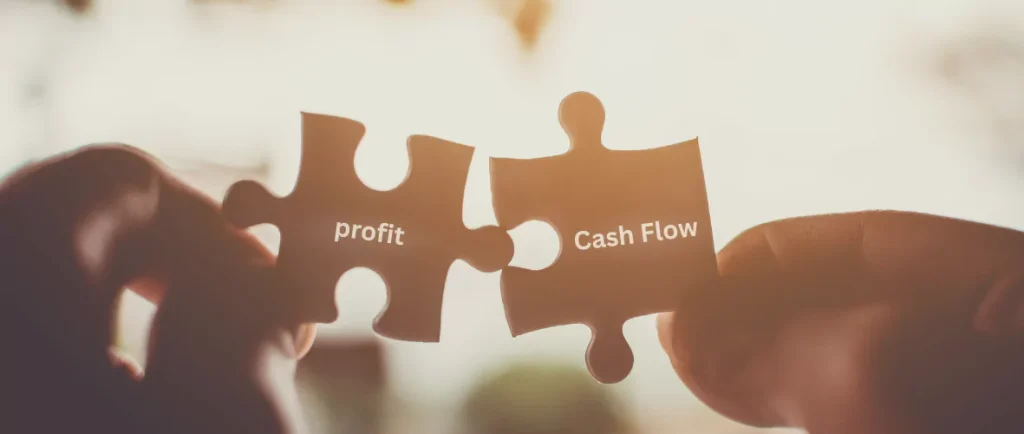Okay, let’s talk about something that trips up so many smart business folks: the whole Cash Flow vs. Profit thing. You see those terms thrown around constantly – in boardrooms, in articles, maybe even whispered nervously over coffee by stressed-out entrepreneurs. And honestly? It’s easy to think they’re basically the same thing. After all, if you’re making a profit, surely you’ve got cash rolling in, right? That is not entirely correct. Confusing these two is like mistaking the gas gauge for the speedometer – both tell you something important about the journey, but mixing them up can leave you stranded on the side of the road.
Think of it this way: Profit is the story your income statement tells. It’s the headline number that says, “Hey, we sold stuff for more than it cost us!” Cash Flow, on the other hand, is the cold, hard reality of money moving in and out of your bank account. It’s the oxygen your business breathes daily. You can be wildly profitable on paper and still be gasping for cash. Conversely, you can have cash flooding in today but be on a path to long-term ruin. Understanding the key differences between Cash Flow vs. Profit isn’t just accounting trivia; it’s fundamental survival knowledge for any business.
So, What Exactly is Profit?
Let’s break it down simply. Profit, often called Net Income or the “Bottom Line,” is what’s left over after you subtract all your business expenses from your total revenue over a specific period (like a month, quarter, or year). Revenue is the total amount you earn from selling your goods or services.
Here’s the basic formula: Profit = Total Revenue – Total Expenses
Seems straightforward? It is, conceptually. But the devil is in the details of timing and accounting rules:
- Accrual Accounting: Most businesses (especially beyond the lemonade stand stage) use accrual accounting. This means revenue is recorded when it’s earned (like when you invoice a customer), not necessarily when you get paid. Similarly, expenses are recorded when they are incurred (like when you receive a bill or use utilities), not necessarily when you pay them. This gives a better picture of true profitability over time but can seriously disconnect from your actual cash situation.
- Non-Cash Expenses: Ever heard of depreciation or amortization? These are expenses that reduce your profit but don’t actually take a single dime out of your bank account right now. They represent the gradual wearing out of assets you bought ages ago.
- The “Paper Profit” Trap: This is where the Cash Flow vs. Profit confusion bites hardest. You might close a huge deal, send out a massive invoice, and boom – your profit for the month looks fantastic! But if that customer takes 90 days to pay… your bank account doesn’t feel any of that “profit” yet. Meanwhile, you still have to pay rent, salaries, suppliers – real cash going out the door.
Profit tells you if your core business model is working. It’s like your business’s report card, showing overall academic performance. But it doesn’t tell you if you have enough lunch money today.
And What About Cash Flow?
Cash flow is far less concerned with academic performance and entirely focused on the immediate reality: Where is the actual money, and when is it moving? It tracks the real, physical inflows and outflows of cash in your business. Think of it as the business’s circulatory system.
Cash flow is typically broken down into three main streams:
- Operating Cash Flow: This is the lifeblood – cash generated or used by your core business operations (selling stuff, paying suppliers, salaries, rent). This is where the Cash Flow vs. Profit disconnect is most evident. Positive operating cash flow means your core business is generating actual cash. Negative means it’s sucking cash out, even if you’re profitable!
- Investing Cash Flow: Cash used for buying (or received from selling) long-term assets like equipment, property, or even other companies. Buying a new delivery van? Big cash outflow here. Selling an old piece of machinery? Cash inflow.
- Financing Cash Flow: Cash moving between the business and its owners or creditors. Getting a loan? Cash inflow. Paying back a loan? Cash outflow. Owners investing more money? Inflow. Paying dividends? Outflow.
The net change in your bank balance over a period is the sum of these three cash flows. Positive Cash Flow means you ended the period with more cash than you started with. Negative Cash Flow means your cash reserves decreased. Simple as that.
Cash Flow vs. Profit: Where the Rubber Meets the Road
So, why the big difference? Let’s highlight the key distinctions:
- Timing is Everything (The Accrual Mismatch): This is the biggest difference of them all. Profit uses accrual accounting (revenue earned, expenses incurred). Cash flow uses cash accounting in its purest sense (money in, money out, when it happens). That gap between sending an invoice (revenue/profit) and receiving the cash (cash inflow) can be a chasm. Similarly, buying inventory (cash outflow now) might not hit your profit until you sell it later.
- Non-Cash Items (The Phantom Expenses): Depreciation is the classic example. Your fancy new server loses value over time – that’s a real cost reflected on your income statement, reducing profit. But you paid for that server months or years ago! That cash is long gone; no new cash goes out for depreciation. Profit reflects the cost, cash flow ignores it.
- Capital Expenditures (The Big Hits): Buying a building or a fleet of trucks? That’s a massive cash outflow now, hitting your Investing Cash Flow hard. But on the profit statement? Only a small portion (the depreciation) trickles through each year. Profit barely flinches at the initial purchase, while cash flow takes a knockout punch.
- Debt & Equity (Financing Doesn’t (Usually) Hit Profit): Taking out a loan? Big cash inflow (Financing), but it’s not revenue, so it doesn’t boost profit. Paying back the principal? Big cash outflow, but it’s not an expense (only the interest is), so profit isn’t directly reduced by the principal repayment. Similarly, getting an investment from an owner boosts cash but not profit. Paying dividends reduces cash but doesn’t hit the profit calculation.
Why Both Matter: You Can’t Survive on Just One

Okay, so they’re different. Is that important? Absolutely! Here’s why mastering the Cash Flow vs. Profit dynamic is non-negotiable:
- Profit Without Cash Flow: The Road to Ruin (aka “Profitability Illusion”): This is the silent killer. Your Income Statement looks stellar. You’re booking sales left and right. But… customers are slow to pay. You had to pre-pay for a huge inventory order. That new machine wiped out your reserves. Suddenly, payroll is due, and your bank account is echoing. You’re profitable but insolvent – unable to pay your immediate bills. Ouch. Without positive cash flow, especially operating cash flow, profit is just a number on a page. You can’t pay employees, suppliers, or the taxman with “profit.” You need cash.
- Cash Flow Without Profit: The Unsustainable Sprint: Maybe you got a big loan or investment. Maybe you sold off some assets. Cash is flowing in! But if your core operations (Operating Cash Flow) are consistently negative and you’re not making a profit, you’re running on fumes. That loan has to be repaid. The investor wants a return. Selling assets only works until you have nothing left to sell. Eventually, the music stops. Positive cash flow from financing or investing can buy you time, but it’s not a long-term strategy. You need underlying profitability to survive and thrive independently.
- Planning & Decision Making: Seeing the Whole Picture: Understanding both gives you superpowers.
- Growth: Want to expand? Profitability shows if it’s fundamentally viable. Cash flow tells you when you can afford it and how to fund it (operating cash? loan?).
- Investments: That new piece of equipment might boost long-term profit (efficiency!), but cash flow analysis tells you the immediate impact and how you’ll cover the cost.
- Debt Management: Lenders care deeply about profit (ability to repay) AND cash flow (ability to make the actual payments on time).
- Valuation: Potential buyers or investors scrutinize both. Strong, sustainable profit attracts interest, but consistent positive cash flow, especially operating cash flow, is pure gold – it shows financial health and independence.
- Surviving the Unexpected: Life (and business) throws curveballs. A key customer delays payment. A supplier raises prices. A global pandemic hits (remember those?). A healthy cash flow position gives you the buffer to weather these storms without immediately jeopardizing operations, even if profits take a temporary hit. Profitability is your long-term goal, but cash flow is your daily lifeline.
Conclusion: Balance, Not Conflict.
So, is it Cash Flow vs. Profit? Absolutely not. It’s Cash Flow and Profit. They are two sides of the same coin, two vital signs of your business’s health. Trying to choose one over the other is like asking if your heart is more important than your lungs. You need both, working together.
- Profitability tells you if your business model is fundamentally sound. Are you creating value efficiently? Are you winning in the marketplace?
- Cash Flow tells you if you can keep the doors open today, tomorrow, and next week. Can you meet your obligations? Can you seize opportunities?
Ignoring profit while chasing cash is a short-term hustle. Ignoring cash flow while celebrating profit is a dangerous fantasy. The most successful businesses obsessively track both. They understand the nuances of accrual accounting, they manage their working capital (receivables, payables, inventory) like pros to optimize cash flow, and they make decisions that strengthen both their profitability and their liquidity.
Don’t just glance at your profit number and call it a day. Dive into your cash flow statement with the same enthusiasm. Understand why they differ each month. That understanding is the difference between navigating your business with confidence and flying blind. Master the Cash Flow vs. Profit dynamic, and you give your business the best possible shot not just at surviving, but truly thriving.








